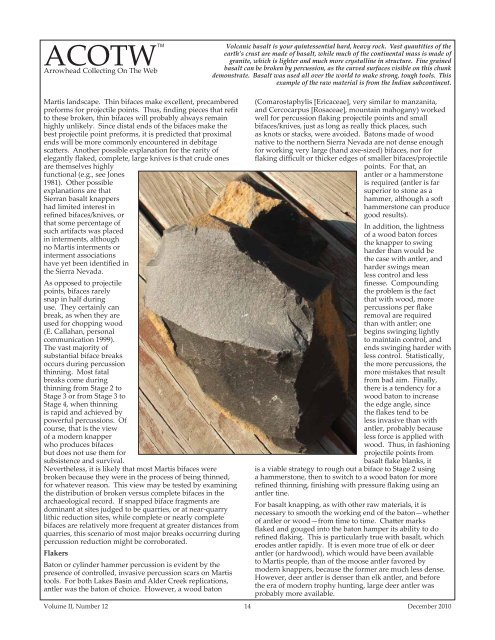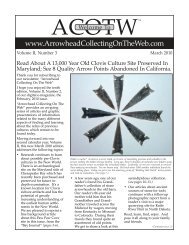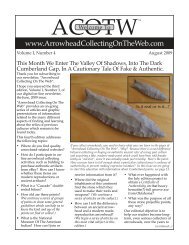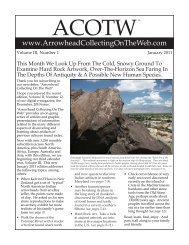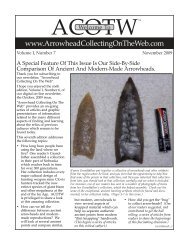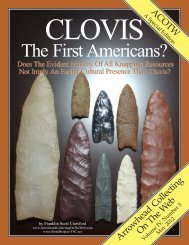Rock, Paper, Scissors - Arrowhead Collecting On The Web
Rock, Paper, Scissors - Arrowhead Collecting On The Web
Rock, Paper, Scissors - Arrowhead Collecting On The Web
Create successful ePaper yourself
Turn your PDF publications into a flip-book with our unique Google optimized e-Paper software.
ACOTW<br />
TM<br />
<strong>Arrowhead</strong> <strong>Collecting</strong> <strong>On</strong> <strong>The</strong> <strong>Web</strong><br />
Martis landscape. Thin bifaces make excellent, precambered<br />
preforms for projectile points. Thus, fi nding pieces that refi t<br />
to these broken, thin bifaces will probably always remain<br />
highly unlikely. Since distal ends of the bifaces make the<br />
best projectile point preforms, it is predicted that proximal<br />
ends will be more commonly encountered in debitage<br />
scatt ers. Another possible explanation for the rarity of<br />
elegantly fl aked, complete, large knives is that crude ones<br />
are themselves highly<br />
functional (e.g., see Jones<br />
1981). Other possible<br />
explanations are that<br />
Sierran basalt knappers<br />
had limited interest in<br />
refi ned bifaces/knives, or<br />
that some percentage of<br />
such artifacts was placed<br />
in interments, although<br />
no Martis interments or<br />
interment associations<br />
have yet been identifi ed in<br />
the Sierra Nevada.<br />
As opposed to projectile<br />
points, bifaces rarely<br />
snap in half during<br />
use. <strong>The</strong>y certainly can<br />
break, as when they are<br />
used for chopping wood<br />
(E. Callahan, personal<br />
communication 1999).<br />
<strong>The</strong> vast majority of<br />
substantial biface breaks<br />
occurs during percussion<br />
thinning. Most fatal<br />
breaks come during<br />
thinning from Stage 2 to<br />
Stage 3 or from Stage 3 to<br />
Stage 4, when thinning<br />
is rapid and achieved by<br />
powerful percussions. Of<br />
course, that is the view<br />
of a modern knapper<br />
who produces bifaces<br />
but does not use them for<br />
subsistence and survival.<br />
Nevertheless, it is likely that most Martis bifaces were<br />
broken because they were in the process of being thinned,<br />
for whatever reason. This view may be tested by examining<br />
the distribution of broken versus complete bifaces in the<br />
archaeological record. If snapped biface fragments are<br />
dominant at sites judged to be quarries, or at near-quarry<br />
lithic reduction sites, while complete or nearly complete<br />
bifaces are relatively more frequent at greater distances from<br />
quarries, this scenario of most major breaks occurring during<br />
percussion reduction might be corroborated.<br />
Flakers<br />
Baton or cylinder hammer percussion is evident by the<br />
presence of controlled, invasive percussion scars on Martis<br />
tools. For both Lakes Basin and Alder Creek replications,<br />
antler was the baton of choice. However, a wood baton<br />
Volcanic basalt is your quintessential hard, heavy rock. Vast quantities of the<br />
earth’s crust are made of basalt, while much of the continental mass is made of<br />
granite, which is lighter and much more crystalline in structure. Fine grained<br />
basalt can be broken by percussion, as the curved surfaces visible on this chunk<br />
demonstrate. Basalt was used all over the world to make strong, tough tools. This<br />
example of the raw material is from the Indian subcontinent.<br />
(Comarostaphylis [Ericaceae], very similar to manzanita,<br />
and Cercocarpus [Rosaceae], mountain mahogany) worked<br />
well for percussion fl aking projectile points and small<br />
bifaces/knives, just as long as really thick places, such<br />
as knots or stacks, were avoided. Batons made of wood<br />
native to the northern Sierra Nevada are not dense enough<br />
for working very large (hand axe-sized) bifaces, nor for<br />
fl aking diffi cult or thicker edges of smaller bifaces/projectile<br />
points. For that, an<br />
antler or a hammerstone<br />
is required (antler is far<br />
superior to stone as a<br />
hammer, although a soft<br />
hammerstone can produce<br />
good results).<br />
In addition, the lightness<br />
of a wood baton forces<br />
the knapper to swing<br />
harder than would be<br />
the case with antler, and<br />
harder swings mean<br />
less control and less<br />
fi nesse. Compounding<br />
the problem is the fact<br />
that with wood, more<br />
percussions per fl ake<br />
removal are required<br />
than with antler; one<br />
begins swinging lightly<br />
to maintain control, and<br />
ends swinging harder with<br />
less control. Statistically,<br />
the more percussions, the<br />
more mistakes that result<br />
from bad aim. Finally,<br />
there is a tendency for a<br />
wood baton to increase<br />
the edge angle, since<br />
the fl akes tend to be<br />
less invasive than with<br />
antler, probably because<br />
less force is applied with<br />
wood. Thus, in fashioning<br />
projectile points from<br />
basalt fl ake blanks, it<br />
is a viable strategy to rough out a biface to Stage 2 using<br />
a hammerstone, then to switch to a wood baton for more<br />
refi ned thinning, fi nishing with pressure fl aking using an<br />
antler tine.<br />
For basalt knapping, as with other raw materials, it is<br />
necessary to smooth the working end of the baton—whether<br />
of antler or wood—from time to time. Chatt er marks<br />
fl aked and gouged into the baton hamper its ability to do<br />
refi ned fl aking. This is particularly true with basalt, which<br />
erodes antler rapidly. It is even more true of elk or deer<br />
antler (or hardwood), which would have been available<br />
to Martis people, than of the moose antler favored by<br />
modern knappers, because the former are much less dense.<br />
However, deer antler is denser than elk antler, and before<br />
the era of modern trophy hunting, large deer antler was<br />
probably more available.<br />
Volume II, Number 12 14<br />
December 2010


